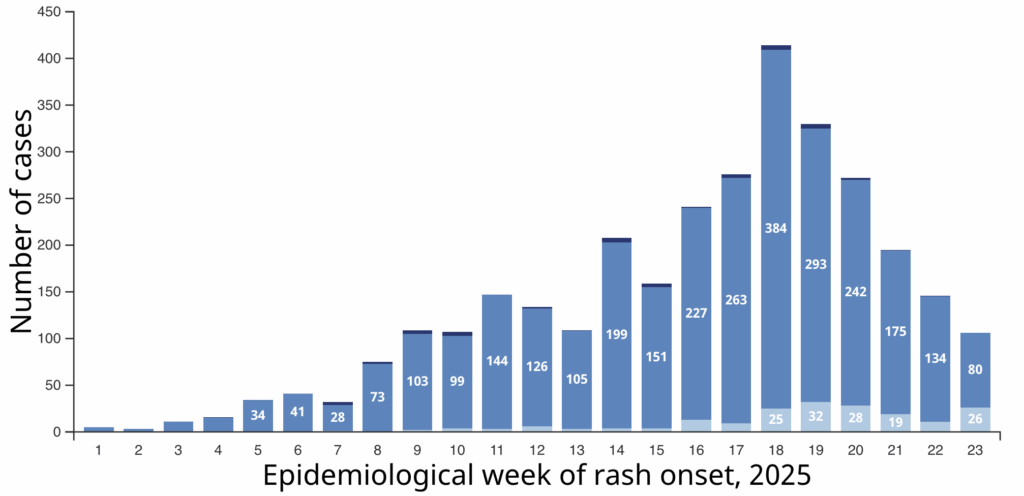🌊 This article from Singapore (2025-06-14) says that their wave is now peaking, about five or six weeks after their wave started in late April. That feels a bit fast to me — we usually see two months from the start to the peak here.
I’m also a bit surprised that COVID-19 growth here has not been as explosive as in Asia. Yet.
COVID-19
Long COVID
🛌 This paper from UK (2025-06-14) reports that people with poor sleep quality prior to infection had a 37% higher risk of Long COVID than those with good sleep quality.
This report from USA (2025-06-12) spills many many words about how bad school absenteeism is for kids, but never examines why kids are absent. Is it because they can’t get a ride to school? They have no clean clothes? They want to stay home and make TikTok videos? Or is it because they have Long COVID? Or perhaps because a parent has Long COVID (and thus has trouble giving them a ride to school in clean clothes)? I really really wish someone would study this.
This graph from USA (sorry, I don’t have one from Canada) shows that the rate of growth of disabled people in the USA changed right at the start of pandemic.
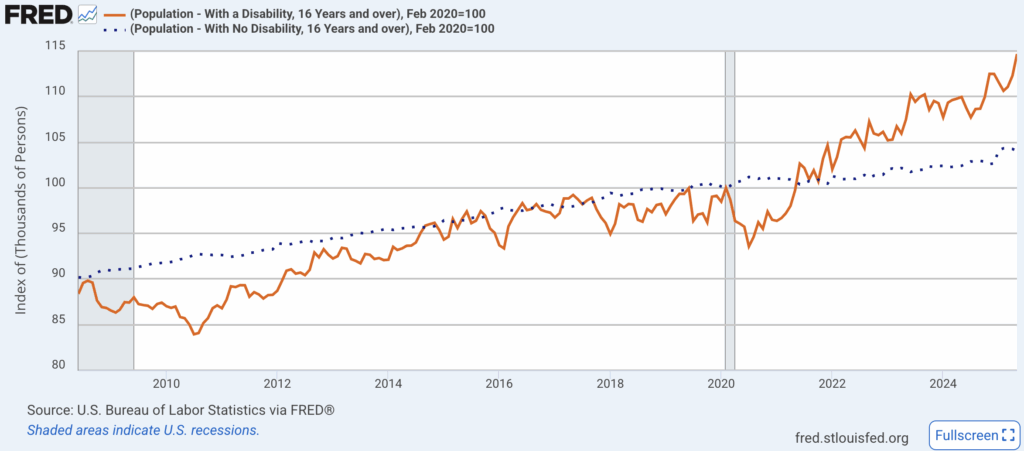
There was an initial dip, but that might have had to do with data gathering being difficult during lockdowns (or maybe because people had fewer accidents when at home?). After a few months, the number of disabled people grew faster than the rate of temporarily-abled people.
I have to believe that the different between the two rates is due to Long COVID.
And note that the increase hasn’t stopped or even slowed down.
👶 This paper from USA (2025-06-09) reports that children who had had COVID-19 infections were much more likely to have self-destructive thoughts and behaviours than those who had not:
- twice the rick of suicidal ideation;
- slightly more than twice the risk of self-harm;
- 2.21 times the risk of poisoning (which I believe includes drug overdoses).
🧠 This paper from India (2025-06-08) about Long COVID patients reports that measures of cognitive function were significantly lower when tumour necrosis factor — a protein which induces inflammation — was higher.
COVID-Related Excess Death and Sickness
🤰 This paper from Brazil (2025-06-11) reports that infants whose mothers had COVID-19 during their third trimester had developmental delays. The percent of infants who had delays was as follows:
| At time | cognitive | communi-cation | motor |
| 6 months | 33% | 20% | 40% |
| 24 months | 36% | 64% | 57% |
NB: The study did not give the percentage of infants who had developmental delays whose mothers did not have COVID (or against historical values).
🍆 This paper from Brazil (2025-03-12) reports that 69% of men in their study had SARS-CoV-2 in their spermatozoa. 😬
This paper from Kazakhstan (2025-06-17) (NB: from a lower-quality journal (MDPI)) reports that about half of ultrasounds of women who had had COVID-19 had abnormalities, compared to 12% in the control group. There was an 11x higher rate of inflammation of the ovaries in the COVID-19 group than in the control group. They also found that the post-COVID-19 women had dysregulated endocrines. 😬
☠️💸 This article from USA (2025-06-11) reports that life insurers saw a 75% increase in death claims over the past five years.
👶 This paper from New Zealand (2025-06-09) reports that children who’d had COVID-19 infections reported statistically significantly worse health compared to healthy controls.
In the part of the paper which was about specific symptoms, they didn’t interview the controls, but the kids who had had COVID-19 said their health was different:
- 24.5% reported having more frequent coughs, colds, and stomach bugs;
- 21.7% reported having more headaches;
- 20.6% reported having more fatigue;
- 14.6% reported having more stomach aches;
- 13.1 reported having new anxiety.
Vaccines
💉 This paper using data from 19 countries (2025-05-28) reports that the risk of getting Guillain-Barré syndrome (GBS) from the AstraZeneca COVID-19 vaccine is 3.10 times the risk of that for unvaccinated people. However, don’t go all anti-vax based on this: the risk of getting GBS from a COVID-19 infection is higher — 3.50 times the risk compared to people with no infection — and the risk of GBS is about halved by getting a Pfizer COVID-19 vaccine.
🏥 This paper from USA (2025-06-17) reports that people who were hospitalized with COVID-19 had much more kidney trouble if they were not vaccinated than if they were:
- 44% higher chance of needing continuous dialysis in the hospital (and the continuous dialysis gives a 182% higher risk of death in hospital and 144% higher risk of death long-term);
- 156% higher chance of needing dialysis when discharged;
- 454% higher chance of death in hospital;
- 378% higher chance of death long-term.
💉 This paper from Canada (2025-06-05) found that repeated COVID-19 vaccinations didn’t compromise (or “wear out”) the immune responses – not in healthy adults, not in frail elderly people, and not in immunocompromised people.
Pathology
☠️ This paper from Israel (2025-05-27) reports that the nucleocapsid protein can move from the infected cells where it gets made, onto the surface of nearby healthy calls. This makes the immune system think those uninfected cells are infected and need to be killed. 😬
🦠 This study from Europe (2025-04-23) reports finding evidence that SARS-CoV-2 can infect human gut bacteria. This has a number of implications:
- SARS-CoV-2 infecting gut bacteria could degrade gut bacteria;
- SARS-CoV-2 viruses could be hiding in the gut bacteria;
- levels of SARS-CoV-2 in gut bacteria could affect the levels in wastewater.
👶 This paper from USA (2025-06-09) reports that children — although having milder respiratory symptoms — had metabolic changes that looked just like those that adults with severe cases had.
👶🏥 This paper from Australia (2025-06-18) says that children in the hospital with COVID-19 did far worse if they had caught COVID-19 in the hospital than if were admitted for COVID-19 that they caught elsewhere:
- 3.8x more likely to need to go on a ventilator;
- about three times more likely to go to the ICU.
I have seen multiple papers that say that people do more poorly with hospital-acquired infections than community-acquired infections, and have wondered why. My hypotheses include:
- COVID-19 in hospitals comes from very sick people, so maybe those viruses have had more chance to mutate?
- People who are in hospital for something else and then get COVID-19 by definition have two things wrong with them, so maybe they are just more fragile?
This paper (2025-06-04) reports that the nucleocapsid protein of SARS-CoV-2 makes the NaV1.7 sodium ion channel — found at the ends of pain-sensing nerves — turn on more easily and stay turned on for longer. In other words, SARS-CoV-2 makes things hurt more for longer. 😬
This preprint from Israel (2025-06-17) reports that 30% of COVID-19 patients in the ICU had reactivation of cytomegalovirus (CMV), with 10% showing clinically significant reactivation. CMV is a herpesvirus, which means it can usually go into hiding in human cells, sometimes for a long time, but like grief, can pop out at times of stress.
This paper (2025-06-09) reports that when scientists thought that growing SARS-CoV-2 in serial passage — letting it grow, taking a sample and transferring it to a new batch of cells, repeat — would mean that at some point, it would reach an end state and stop mutating. Unh-unh. They ran the suckers through 100 passages and they kept mutating.
Transmission
This press release from Puerto Rico (2025-06-20) about a conference presentation reports that COVID-19 case rates correlated with high levels of airborne fungus. I first thought that this was just another example of “gunk in the air makes you more susceptible to respiratory infections”, but they did not find a correlation with pollen levels.
Mitigation Measures
😷 The federal government is selling boxes of 440 Aura 1870+ respirators on their auction site! There are at least seven boxes at Langley with bids under $21 as of 20 June 2025. Shipping from Langley costs about $25; it’s more from Ontario or Saskatchewan.
I got myself a box!
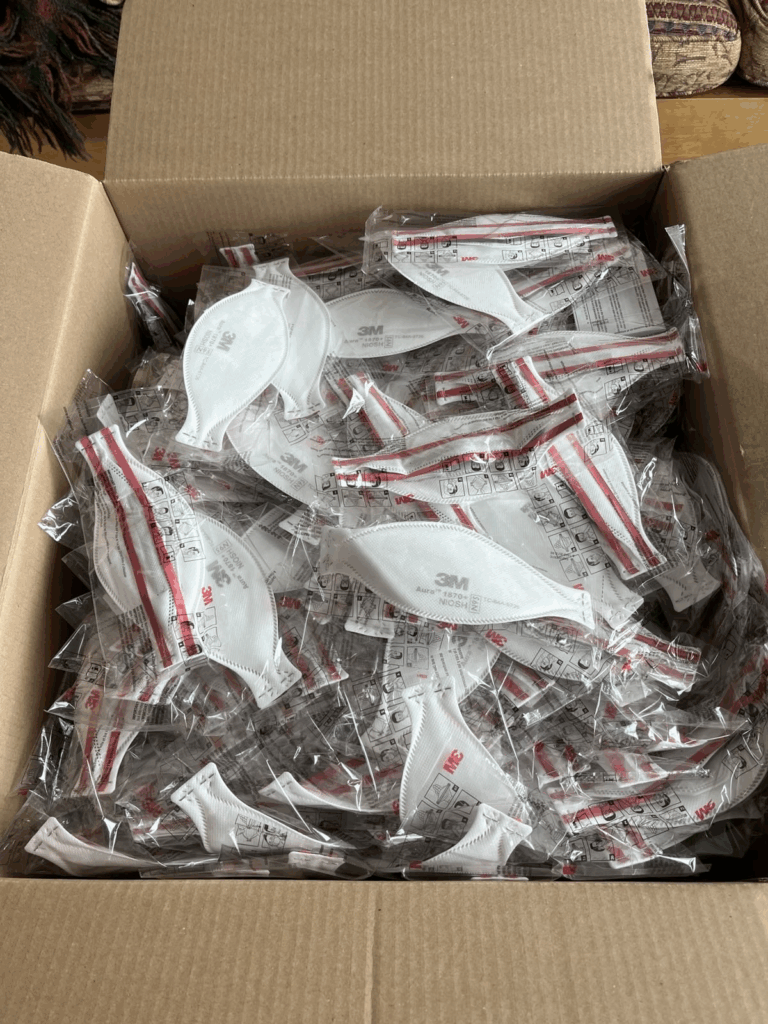
They expire “soon” (my box expires in 14 months), but that still seems like a really good deal. (This page says that the filtration stays good well past the expiry date; I’ve seen info elsewhere that the elastic straps fail first.)
This box at Langley is going for $15 as of 20 June 2025, and expires in 14 months.
Auction site:
https://www.gcsurplus.ca/mn-eng.cfm, search for Aura.
Treatments
This paper (2025-05-30) reports finding some nanobodies (the analogue to antibodies in the 🐪 camel family) which work really well at neutralizing multiple variants of SARS-CoV-2 and SARS. Basically, nanobodies are like tiny antibodies which lock the spike protein in a configuration which can’t enter cells. Like monoclonal antibodies, the nanobodies can be used either as a treatment or a preventative.
Testing
This preprint from Switzerland (2025-06-17) found that rapid antigen tests suck even more for Omicron than for Delta. They found that just under half of the rapid tests they tested found Omicron infections, compared to about 65% for Delta. They also found quite a wide variation in the rapid tests’ accuracy.
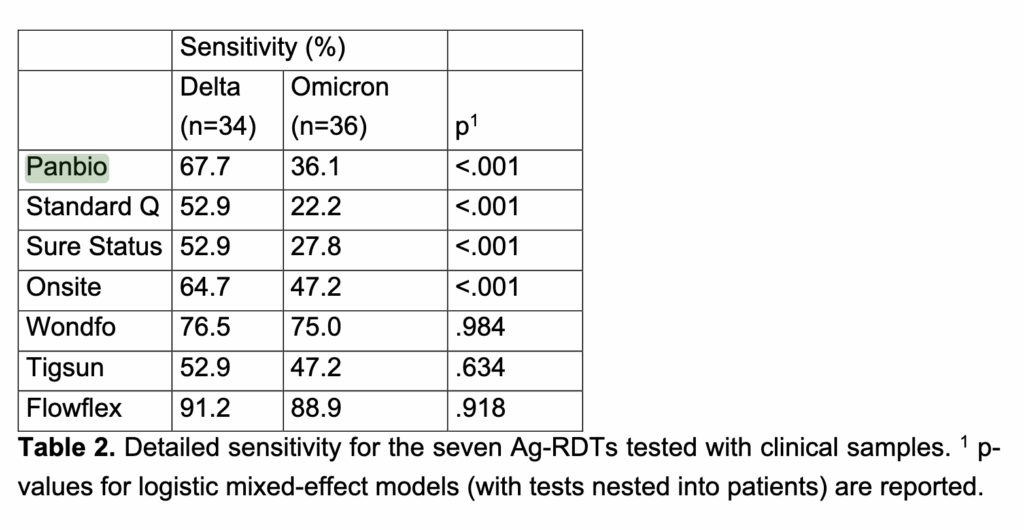
In BC, the blue-box RATs are Panbio and the green-box RATs are BTNX, which wasn’t evaluated in this preprint.
Canadian Healthcare System
This article (2025-06-13) says that Dr. Theresa Tam will be stepping down as Canada’s chief public health officer on 2025-06-20.
🏥 This article (2025-06-17) reports that two hospitals and one care home in BC have declared COVID-19 outbreaks: Peace Arch Hospital in White Rock, Penticton Regional Hospital and Cottonwoods in Kelowna.
The article says that visitors will have to disinfect their hands when they enter and exit. There’s no mention of masking for a FRICKIN’ AIRBORNE VIRUS. 🤦♀️
💉 This article (2025-06-13) reports that Alberta is now charging most people for COVID-19 vaccines. People in congregant housing, clinically vulnerable people, people on income support, and the homeless will still get shots for free; everybody else — even the elderly — will have to pay for it.
The premier of Alberta claims this is a cost-saving measure, but note that vaccination costs a lot less than hospitalization.
BC Wastewater
💩 COVID-19 levels in Fraser Health has been obviously going up for a while. The other treatment plants’ levels have been going up as well, it’s just harder to see because the levels are lower.
From Jeff’s spreadsheet:
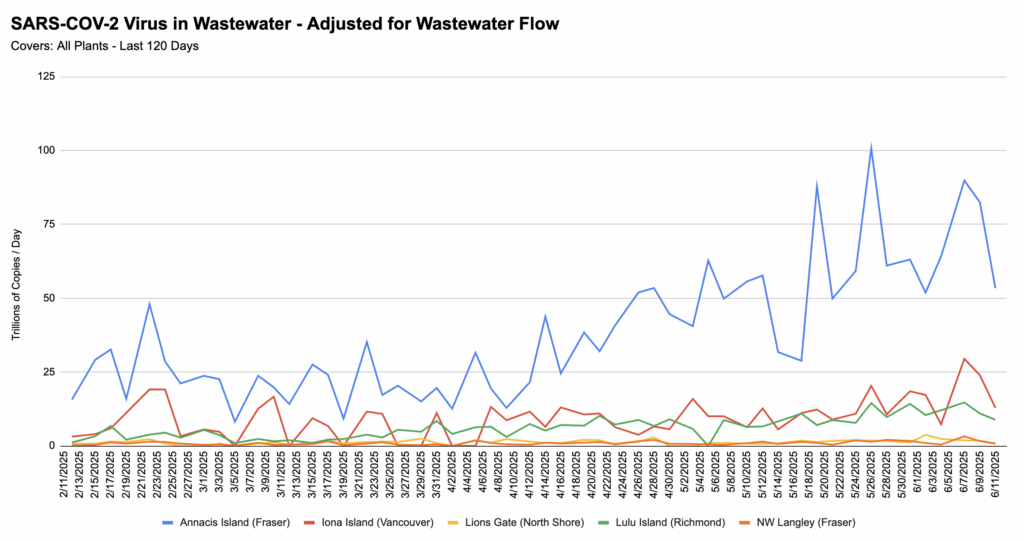
Recommended Reading
This article (2025-06-17) is heartbreaking: it tells about how a strong medical research infrastructure was built up in South Africa, and Trump’s administration has ruined it.
Measles
Transmission
The Government of Canada’s Measles and Rubella Monitoring Report (2025-06-16) says that in the week ending 2025-06-07, there were 202 new measles cases in Alberta, Manitoba, Ontario, and Saskatchewan. The number of cases is declining:
